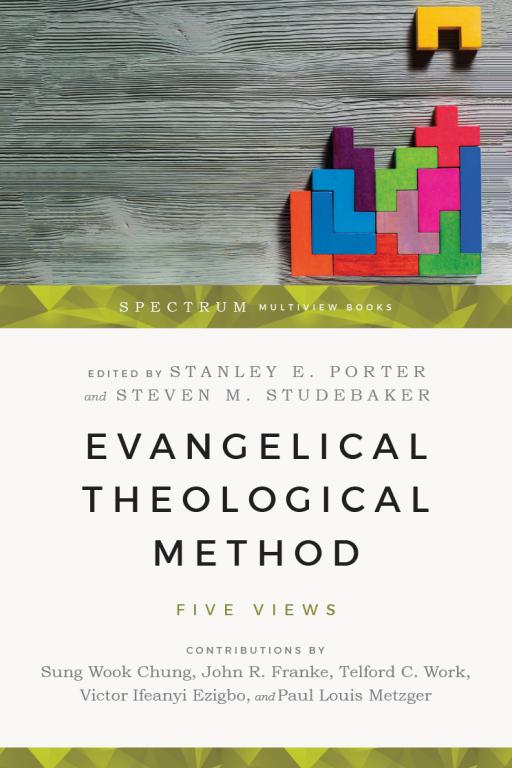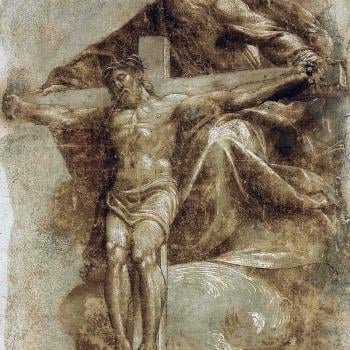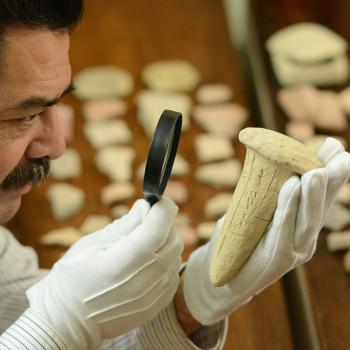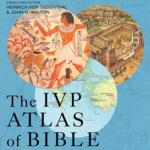
The following is an interview with the editors of a timely, new volume published by InterVarsity Academic on the subject of theological method. The interview on “Evangelical Theological Method: Five Views” with editors Stanley E. Porter and Steven M. Studebaker addresses pressing challenges theologians face today in accounting for and developing theological method. One such challenge is that many scholars and students often function as “Nike theologians,” that is, “they just do theology.” Another challenge is that many approach theological method with a “‘Mordor’ attitude,” just like in Tolkien’s celebrated trilogy where Sauron binds all the rings forged in the fires of Mount Doom to one master ring. Whereas some theologians will argue there is a master method that overshadows and even discounts other theological methods, the editors maintain there is no one theological method “to rule them all.” Born out of the necessity of addressing these and other challenges, this book highlights the vital importance of making clear one’s theological method while accounting for the rich diversity of methodologies in the theological enterprise.
Paul Louis Metzger (PLM): What led the two of you to edit a book on theological method?
Steven M. Studebaker (SMS): First and primarily, we wanted to help students in theological studies. Faculty review of doctoral dissertation proposals revealed that theological studies students have fewer resources, relative to their colleagues in biblical studies, for thinking through how to approach and research their theses and dissertation topics. Second, we wanted to provide a resource that illustrates the “how” and not only the “what” of theological method. A lot of books on theological method are strong on defining what theology is or the “what.” For example, we found some books that define theology in particular ways. We may agree with how they do this. But, how does a student write a paper, thesis, or dissertation that reflects this orientation? Where do they start? What comes next? We wanted to give them something that outlines the theoretical and theological vision for approaching theology as well as how to implement it in practical terms. Third, we hoped to produce a resource that would help faculty at other institutions mentor students.
Stanley E. Porter (SEP): Let me just add that this is a book that was born out of necessity, as Steve has intimated. We mention this in our opening chapter, but we came up with the idea immediately after a faculty meeting—one among many recurring debates—when we had debated why a student had presented a dissertation proposal that did or did not have a particular method and why some methods were well articulated and others were not. We became very concerned that students in theology simply were not aware of and did not have access to discussions of theological method. We were not convinced from what we were seeing that such knowledge was implicit or assumed—we were seeing that it simply was not there and needed to be. We also realized that questions of theological method are not easily resolved simply by invoking a single method, so we thought that a multiple views approach, in which advocates for the various positions presented and defended their positions, would make the best means of presenting the range of views.
PLM: What went into the decision-making process for selecting these five approaches to theological method? What are some other approaches to theological method that you could have chosen for consideration?
SEP: At first we thought very broadly about various approaches to theological method and were not constrained by any particular theological stance. As you can imagine, this led to a fairly lengthy list of various ways in which theology has been methodologically done during the recent modern period. We soon realized that we could not go so broadly, especially because many of these ways of doing theology were either out of date or were not being used by Evangelicals. Correlational theology, for example, is mentioned in the book, and it has had a huge impact on theology as a whole, but it has not played an important role in evangelical theology. So we needed to narrow our focus and concentrate upon evangelical theology.
SMS: We had several conversations about ways that Evangelicals approach the doing of theology. The evangelical focus of the volume became the deciding factor in selecting the methods. The Bible doctrines or propositional approach was the first and most obvious way of doing theology among Evangelicals. Even if it has come under criticism in the last few years, it remains historically and probably even today the most popular way of doing evangelical theology. Beyond that, we tried to place different ways Evangelicals do theology in categories. That led to Missional Theology, which includes what some call post-conservative theology. We liked Missional because it puts the emphasis on what theology is rather than what it rejects. The Dogmatic approach recognizes the ongoing popularity and influence of Karl Barth for evangelical theology. The interdisciplinary and contextual methods provided categories for the current diversification of approaches in evangelical theology. The selection of five methods was due to the parameters of the Spectrum Multiview Books series with InterVarsity Academic Press. Approaches that we considered but left out were various advocacy methods, postmodern (although some would say the missional, interdisciplinary, and contextual approaches fall in this category), and Pentecostal theology. Passing on these other approaches is not a negative judgment on them. But with needing to select five ways, we tried to select methods that were representative of what’s going on in evangelical theology. Indeed, we have talked about doing another volume on theological method that would surely include them!
PLM: What were some of the pleasant surprises and painstaking struggles you experienced over the course of the editing?
SMS: The Bible Doctrines approach was the most straightforward chapter both for the author to write and for us to edit. Conversations with the authors of the other four chapters revealed that theological method often functions implicitly, perhaps even subconsciously. They intuitively use their method, but detailing the steps for doing so was a challenge. I think many scholars and students are Nike theologians–they just do theology.
SEP: I think that Steve captures it well, when he singles out the Bible Doctrines approach from the others. I suspect there are those who think that that is “the” approach to evangelical theology and that the others are either dependent upon it or in some way compromised in relationship to it. However, I think that in the end the essays were sufficiently well nuanced from each other that we can see genuine and substantive differences among the approaches—differences that make a difference in theology. This often comes through in the responses. I hope that readers of the volume will also have benefited from the work that the authors and we as editors did to ensure that the essays were focused and specific in what they conveyed so that these differences emerged.
PLM: How would you encourage theologians in training to use the book for their own disciplinary work?
SEP: This is definitely a student-oriented book in that it is designed to lay out in a relatively short amount of space the five different theological methods. There may be fledgling theologians who have no real understanding of their theological method, and for them this could be a great introduction that will help them to determine their method and distinguish it from others, as a means of getting them to explore further. However, I would also like to think that this book could be used by those with some previous and even advanced knowledge to gain a clearer idea in their own minds of how their position relates to others, or to reinforce or even challenge some of their own methodological presuppositions. Just because someone holds to a particular position does not mean that they have to continue to hold to that method.
SMS: I hope the book serves as a resource in three ways—research and writing, lecturing, and mentoring. First, the five methods can provide a guide for scholars and students for how they can approach their research and writing—the common application of each method to the topic of Christology will particularly be helpful on this score. Second, the methods detailed in the volume will serve as a basis for professors developing lectures, especially for teaching in the area of theology and in particular theological method. Third, I hope that professors will draw on this book to support their advising students on ways to approach writing papers, theses, and dissertations.
PLM: What is your hope for evangelical theology as it relates to theological method, and how does the volume help toward that hope’s fulfillment?
SEP: Evangelical theology has probably been too univocal in the past—or at least ostensibly so—without recognition of underlying diversity, much of which diversity probably originates methodologically. I would be content if this volume helps us gain methodological rigor and insight. My contention has long been that method is crucial to any academic enterprise, as it serves a fundamental role in determining what counts for evidence and how that evidence is evaluated. I also believe that we need to start with method if we are going to finish well. Without a clear method in any research, we have no real idea of where we are or what we are doing or whether we are even accomplishing anything at all.
SMS: I want to see a wider recognition among evangelical theologians that multiple ways of doing theology can enrich evangelical theology. We should get away from a ‘Mordor’ attitude: One method to rule them all . . . . One method can neither say everything that needs to be said nor address every question that needs answering. The authors in this volume capture that spirit. They put forward their views with enthusiasm and conviction, but at the same time recognize the value of the work of their colleagues in the volume. The respectful dialogue that takes place in the book is itself a model of a theological method—perhaps an intra-evangelical ecumenical style.












